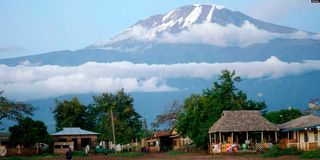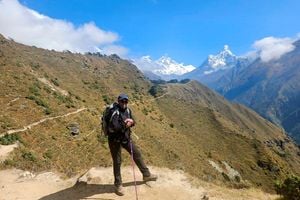Mt Kilimanjaro’s vanishing ice prompts Unesco's Sh1bn intervention

Houses sit near the foot of Mount Kilimanjaro. The melting glaciers of Kilimanjaro, a UNESCO World Heritage Site since 1987, pose an imminent threat to more than two million people in Tanzania and Kenya, according to UNESCO.
What you need to know:
- Scientists predict that glaciers on both Mount Kilimanjaro and Mount Kenya could completely disappear by 2040, making them among the first mountain ranges in the world to be completely deglaciated due to climate change.
In a race against time, Unesco has launched an $8 million initiative (Sh1.03 billion) to address the imminent threat posed by rapidly melting glaciers on Mount Kilimanjaro, highlighting the urgent climate crisis facing East Africa's iconic mountain ranges.
The project, announced on March 7 by Unesco Director-General Audrey Azoulay during a meeting with Tanzanian President Samia Suluhu, comes as scientists predict that glaciers on both Mount Kilimanjaro and Mount Kenya could completely disappear by 2040, making them among the first mountain ranges in the world to be completely deglaciated due to climate change.
"The melting glaciers of Kilimanjaro, a Unesco World Heritage Site since 1987, pose an imminent threat to more than two million people in Tanzania and Kenya," said Mr Azoulay. "The international community must support the authorities and local populations to protect this vital resource."
The loss of these glaciers represents more than just the disappearance of a spectacular natural feature. Mount Kilimanjaro serves as a critical water tower for the region, with its glaciers, rainfall, and cloud forests feeding rivers and groundwater systems that millions of people depend on for their daily water needs, agriculture, and economic activities.
"These mountains have historical glaciers that have existed for thousands of years. What we're witnessing now is unprecedented in human history – the complete disappearance of these ice caps within a single generation," a State of Climate in Africa report said.
The Unesco initiative, financed by the Global Environment Facility and implemented in partnership with the Food and Agriculture Organization (FAO), will take a multi-faceted approach to address both immediate water needs and long-term ecosystem sustainability.
A key component involves mapping the region's aquifer systems to improve groundwater management, with the goal of providing an additional 100,000 people with direct access to drinking water. The project will also enhance groundwater storage and supply during increasingly severe dry seasons, benefiting 615,000 people currently vulnerable to water shortages.
To monitor these critical resources, a scientific observation center will be established, fostering cross-border cooperation between researchers in Kenya and Tanzania. An initial meeting to establish this center was held this week in Arusha, Tanzania.
“Perhaps most significantly, the initiative recognises that the region's water security doesn't depend solely on glaciers. Cloud forests play a crucial role in capturing moisture from fog and clouds, feeding springs and streams even when rainfall is scarce. Unesco plans to support the restoration of 400 square kilometres of cloud forests, which are vital for water retention and groundwater replenishment,” Unesco said.
Deforestation, often driven by agricultural expansion and charcoal production, has intensified the impacts of climate change in the region, and as part of the project, local communities will be supported to restore damaged forests.
The initiative comes as part of the International Year of Glacier Preservation, led by Unesco and the World Meteorological Organisation. The first World Day for Glaciers will be marked on March 20.
For East Africa, the consequences of deglaciation extend beyond water scarcity. Tourism, a major economic driver for both Kenya and Tanzania, will likely be affected as the iconic snow-capped peaks that have drawn visitors for generations disappear. The glaciers also hold cultural significance for local communities who have traditional connections to these mountains.
Climate scientists point to this rapid glacial retreat as yet another visible indicator of global climate change. While African nations contribute minimally to global greenhouse gas emissions, they are disproportionately affected by its consequences.
“The deglaciation of Kilimanjaro and Mount Kenya represents one of the clearest and most dramatic examples of climate change impacts in Africa,” scientists said in the State of Climate in Africa report.
While the $8 million investment addresses immediate adaptation needs, scientists stress that only significant global reduction in greenhouse gas emissions can slow the pace of glacial melt. Without such action, East Africa's mountains will likely stand as bare sentinels – early casualties in a changing climate where ancient ice fields once stood for millennia.
zwandati@ke.nationmedia.com


